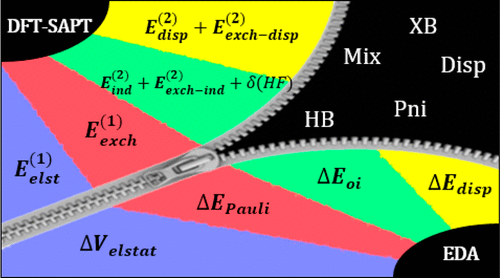当前位置:
X-MOL 学术
›
J. Chem. Theory Comput.
›
论文详情
Our official English website, www.x-mol.net, welcomes your
feedback! (Note: you will need to create a separate account there.)
Comparison of the DFT-SAPT and Canonical EDA Schemes for the Energy Decomposition of Various Types of Noncovalent Interactions
Journal of Chemical Theory and Computation ( IF 5.7 ) Pub Date : 2018-06-21 00:00:00 , DOI: 10.1021/acs.jctc.8b00034 Olga A. Stasyuk 1 , Robert Sedlak 1, 2 , Célia Fonseca Guerra 3, 4 , Pavel Hobza 1, 2
Journal of Chemical Theory and Computation ( IF 5.7 ) Pub Date : 2018-06-21 00:00:00 , DOI: 10.1021/acs.jctc.8b00034 Olga A. Stasyuk 1 , Robert Sedlak 1, 2 , Célia Fonseca Guerra 3, 4 , Pavel Hobza 1, 2
Affiliation

|
Interaction energies computed with density functional theory can be divided into physically meaningful components by symmetry-adapted perturbation theory (DFT-SAPT) or the canonical energy decomposition analysis (EDA). In this work, the decomposition results obtained by these schemes were compared for more than 200 hydrogen-, halogen-, and pnicogen-bonded, dispersion-bound, and mixed complexes to investigate their similarity in the evaluation of the nature of noncovalent interactions. BLYP functional with D3(BJ) correction was used for the EDA scheme, whereas asymptotically corrected PBE0 functional for DFT-SAPT provided some of the best combinations for description of noncovalent interactions. Both schemes provide similar results concerning total interaction energies and insight into the individual energy components. For most complexes, the dominant energetic term was identified equally by both decomposition schemes. Because the canonical EDA is computationally less demanding than the DFT-SAPT, the former can be especially used in cases where the systems investigated are very large.
中文翻译:

各种非共价相互作用的能量分解的DFT-SAPT和规范EDA方案的比较
利用密度泛函理论计算出的相互作用能可以通过对称自适应扰动理论(DFT-SAPT)或规范能量分解分析(EDA)划分为物理上有意义的成分。在这项工作中,比较了通过这些方案获得的分解结果,分析了200多个氢,卤素和pogenogen结合,分散体结合和混合的复合物,以研究它们在评估非共价相互作用性质方面的相似性。具有D3(BJ)校正功能的BLYP用于EDA方案,而对于DFT-SAPT具有渐近校正功能的PBE0提供了一些描述非共价相互作用的最佳组合。两种方案都提供了有关总相互作用能和对单个能量成分的洞察力的相似结果。对于大多数复合物,两种分解方案都平等地确定了主要的高能项。由于规范的EDA在计算上比DFT-SAPT要求低,因此前者尤其适用于所研究的系统非常庞大的情况。
更新日期:2018-06-21
中文翻译:

各种非共价相互作用的能量分解的DFT-SAPT和规范EDA方案的比较
利用密度泛函理论计算出的相互作用能可以通过对称自适应扰动理论(DFT-SAPT)或规范能量分解分析(EDA)划分为物理上有意义的成分。在这项工作中,比较了通过这些方案获得的分解结果,分析了200多个氢,卤素和pogenogen结合,分散体结合和混合的复合物,以研究它们在评估非共价相互作用性质方面的相似性。具有D3(BJ)校正功能的BLYP用于EDA方案,而对于DFT-SAPT具有渐近校正功能的PBE0提供了一些描述非共价相互作用的最佳组合。两种方案都提供了有关总相互作用能和对单个能量成分的洞察力的相似结果。对于大多数复合物,两种分解方案都平等地确定了主要的高能项。由于规范的EDA在计算上比DFT-SAPT要求低,因此前者尤其适用于所研究的系统非常庞大的情况。











































 京公网安备 11010802027423号
京公网安备 11010802027423号